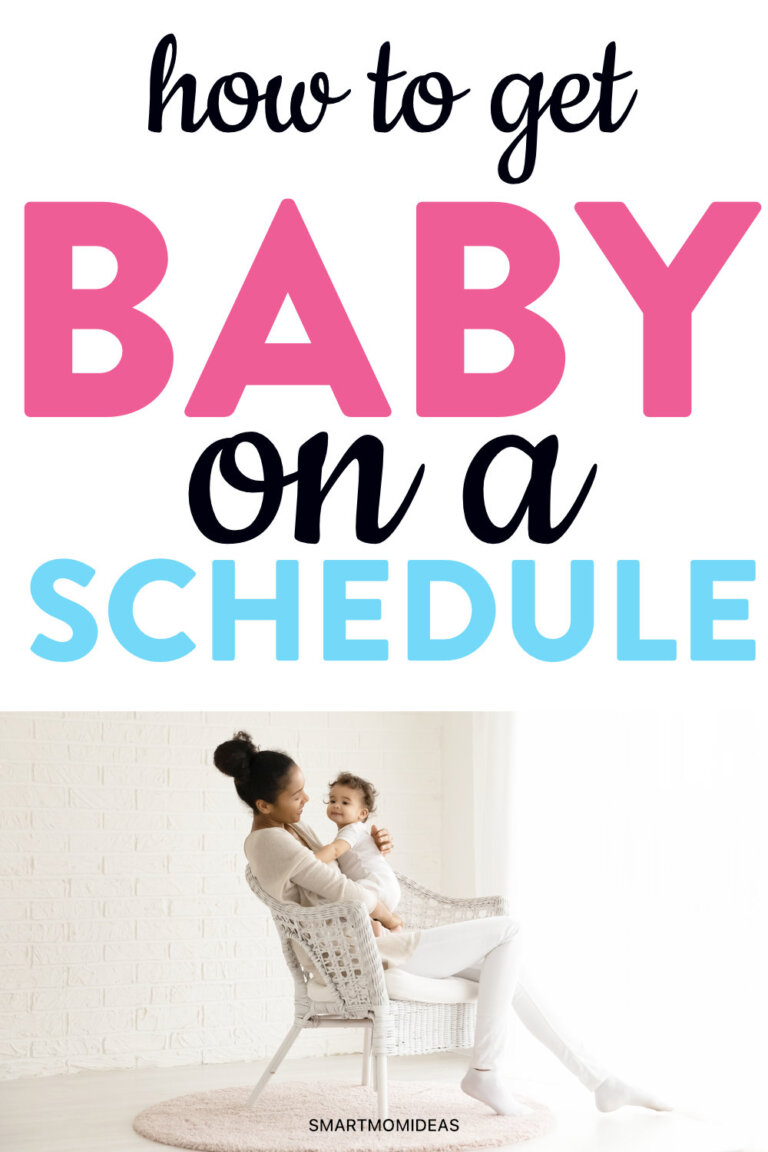The easy way to get your baby on a schedule.

Let’s face it, your baby has no regard for your schedule.
You try and get up early to take a shower and get ready before your little one gets up?
Good luck with that one…
What, you want them to take a nap so you can get some work done or just eat a hot meal?
Unlikely…
While you might have had a great schedule before your little one arrived, now your baby is just along for the ride and will interrupt your plans every chance they get.
So you might be desperately wondering, how to get a baby on a schedule?
Well, the short answer is…it’s all about consistency.
You need to be consistent with daily, nap, and sleeping schedules to get your little one to be on an established schedule rather than flying by the seat of your pants.
This what I had to do with my twins. While other moms of twins cherished time with one child as the other slept, I knew better.
I knew that if I wanted to take care of myself and sanity, I had to get my twins on the same schedule no matter what.
While it’s going to depend on what your day normally looks like, it’s still possible to put your little one (or ones) on a regular and consistent baby schedule.
Whether you stay home with them or work full time, it’s possible.
Getting your baby on a schedule can help moms stay organized and be a lifesaver when it comes to her sanity.
Of course you don’t want to be so rigid in your scheduling that you are ignoring your child’s cues for hunger or sleep.
While having a newborn schedule is great, you still need to be flexible.
Let’s take a look at how to establish day time schedules, schedules for naps, and for bedtime routines.
The Daily Schedule
This is going to vary based on whether you work outside of the home full time or whether you are home with your baby all day.
It’s not so much as a strict schedule, like we wake up every day at this time, have breakfast at this time and so on.
That is not always realistic. It’s more about the pattern or cycle that you are putting your baby through everyday.
What are you doing when you get up every morning?
Are you taking a few minutes to snuggle?
Feeding them right away?
Changing them and getting them dressed?
Do you have other children you have to care for and get off to school in the mornings?
The way you start your mornings off can really set the tone for the rest of the day.
Starting the day off in a hectic manner is just going to stress both of you out.
If at all possible, take the morning slow.
Establish a simple routine that works for both of you while accommodating for other obligations, such as older kids or getting to work.
When my twins were four months old, in the morning, my mother-in-law and myself would feed a baby then take turns giving a baby a bath.
My mother-in-law would do a load of baby clothes for me (such a godsend!) while I set up tummy time for my twins on the floor. I then was able to pump and watch my twins have fun.
Your baby will learn quickly and even though it might not seem like it right away, they are learning from everything you do with them.
If they are still too small to move around themselves, be sure that you are holding and carrying them lots during the day.
A Moby wrap was perfect for then my baby’s were very little!

If they are always laying down, they are not going to know the difference between when they are supposed to sleep and when they are supposed to be awake.
The Nap Schedule
You don’t always want to wait until your baby falls asleep to lay them down for a nap.
It’s perfectly ok to lay them down for a nap during the daytime while they are still awake.
While it can be a huge relief for your little one to sleep for 3-4 hours during their afternoon nap time, this can have negative effects on their ability to fall asleep when it comes time to go to bed at night.
It’s suggested that 2 hour naps are enough for them to get adequate rest and then wake up for playtime.
As a general rule, babies do tend to sleep better when they have a full tummy.
You can give them some solid foods for lunch if they are eating solids, followed by a feeding session.
If at all possible, have their feeding session (bottle or breast) in a quiet area so they are not distracted and too busy looking at other things to eat.
It’s a good idea to set up a routine for both naps and bedtime.
Sit in a room with low lighting, turn on a fan or white noise machine to help drown out any outside noises.
This helps to make your baby realize that it’s time to sleep, not time to play.
Once it is time to wake them up, if they aren’t waking up on their own, make a routine for this too.
Don’t just turn the lights on full blast and pull them out of bed. Wake them up softly just as you put them to bed.
My twins were rockstars for the first four months of napping consistently three times a day.
But then my daughter started to wake up sooner or miss naps.
I had to learn to adjust to this new schedule and it turned out fine!
So, if you find your little one waking up earlier and earlier each nap, take it in stride!
The Sleep Schedule
Setting up a sleep schedule is very similar to setting up a nap schedule, however, there are a few differences when it comes to getting your baby to sleep longer through the night.
If you lay your baby down in their nursery for bed between 7pm and 8pm every night, you can do a technique called dream feeding between 10 and 12pm, which should allow you to get some more sleep.
Dream feeding is simply bottle or breastfeeding your baby while they are still “sleeping” to fill up their tummies to help them sleep longer.
You are not completely waking them up to feed them but rather trying to have them remain sleeping while feeding them.
One of the toughest parts of getting your baby on a sleep schedule for many parents is letting their little ones self soothe.
This is often referred to as “crying it out.”
This self soothing training allows babies to realize that they can fall back to sleep by themselves without having to have another feeding or being rocked back to sleep.
It’s suggested to do sleep training between the ages of four to six months, however it depends on your baby’s development.
When they are a bit younger they do not get too used to you soothing them to get them back to sleep (or can sit up and start to climb out of their crib on their own).
One of the goals is to be able to lay baby down while they are still awake enough and are able to fall asleep in their bed rather than in your arms.
Developing a longer bedtime routine for baby is a great way to help get him or her ready for bed and let them know it’s time for sleep.
This could include having a nice, warm bath, dimming the lights, minimizing distractions and turning on a white noise machine, a little massage with some lotion or oil, reading a book, swaddling them or putting them in warm jammies, feeding them, and then singing to them until they are almost asleep.
It might take you a bit to figure out a routine that works for you and your baby, but stick with it!
When to Start Your Baby on a Schedule
Experts don’t really agree on when it is best to start a routine for your baby.
However, having a routine for your baby and yourself can be a great way for mom to feel more organized.
Take your time to enjoy your new little bundle of joy without having to worry about scheduled nap times and everything else.
The first month of your baby’s life you should soak in with every ounce of your being. It’s a special time where they sleep a lot, which also gives you the time to rest and recover a bit.
Between the ages of two to four months is generally when you should try and establish a routine for your baby.
Before you start to impose a routine on your little one, look for their cues.
When are they generally falling asleep?
Do they need a few shorter naps during the day or are they taking one or two longer naps?
Do they seem very hungry right away in the morning or do they prefer to wait an hour or so after waking up to eat?
No matter what type of routine that you establish, it’s essential that the well-being of your baby comes first.
Wrap Up
We briefly talked about this in the beginning of this article, but let’s dive into it more here.
It doesn’t really matter what your schedule says, you should follow your gut, your baby’s cues, and any advice from your doctor.
Don’t ever forgo feeding your baby because it’s not the right time in the schedule if they are showing signs of hunger.
During that first 12 months they need a lot of fluids and breastmilk or formula to properly gain weight and stay hydrated.
You can either go with a more established parent-led schedule, a more laid back baby-led schedule, or a combination of both.
Whatever is going to work for you and your baby the best, don’t worry about what other moms are doing either.
Even with a baby-led schedule, you still start to see patterns develop in your baby’s behaviors when they want to sleep, eat, and play.
Do you have a schedule for your baby? Let me know in the comments below!
Please pin me!




Leave a Reply